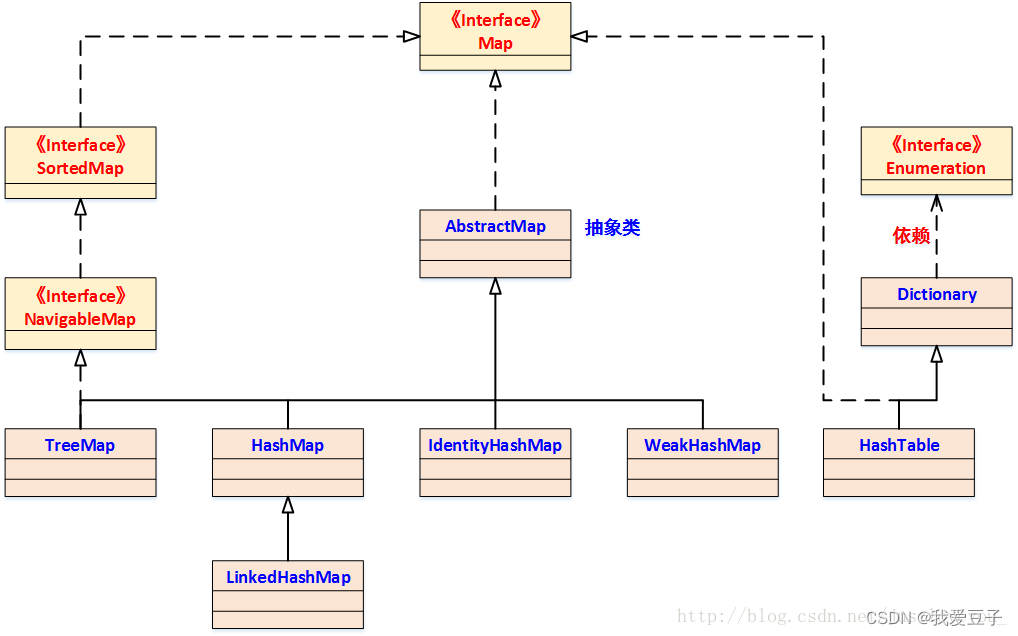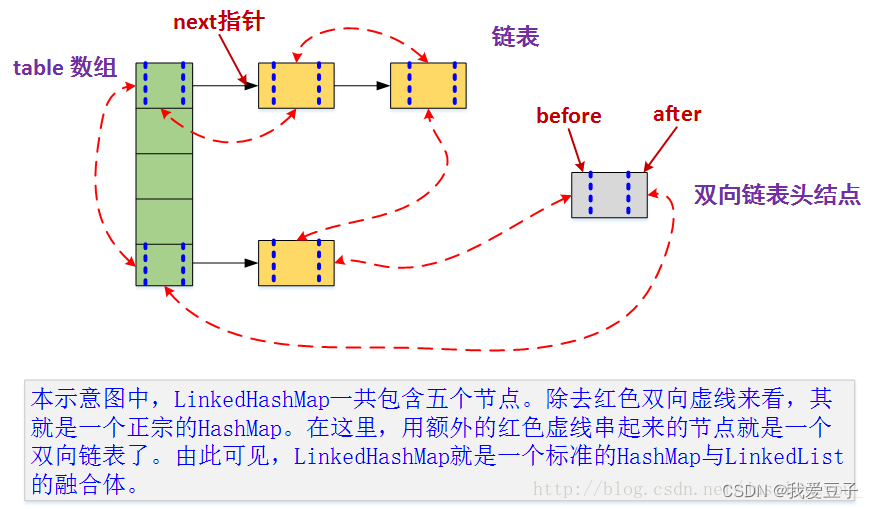一、LinkedHashMap
1.定义:
LinkedHashMap是HashMap和双向链表的合二为一,即一个将所有Entry节点链入一个双向链表的HashMap(LinkedHashMap = HashMap + 双向链表)
- LinkedHashMap和HashMap是Java Collection Framework 的重要成员,也是Map族(如下图所示)
- LinkedHashMap是HashMap的子类(拥有HashMap的所有特性)
- LinkedHashMap和HashMap最多只允许一条Entry的键为Null(多条会覆盖),但允许多条Entry的值为Null
- LinkedHashMap 也是 Map 的一个非同步的实现
- LinkedHashMap很好的支持LRU算法
- HashMap是无序的,LinkedHashMap通过维护一个额外的双向链表保证了迭代顺序
- 迭代顺序可以是插入顺序,也可以是访问顺序(即根据链表中元素的顺序可以将LinkedHashMap分为:保持插入顺序的LinkedHashMap和保持访问顺序的LinkedHashMap,其中LinkedHashMap的默认实现是按插入顺序排序的)

LinkedHashMap的原理图:

LinkedHashMap和HashMap的Entry结构图:

2.LinkedHashMap在JDK中的定义
LinkedHashMap继承关系:
- public class LinkedHashMap<K,V>
- extends HashMap<K,V>
- implements Map<K,V>
LinkedHashMap成员变量:
- 相比于Hashmap,LinkedHashMap新增 双向链表头结点header和标志位accessOrder
- accessOrder:
- 默认为false(即默认按照插入顺序迭代)
- 为true时(按照访问顺序迭代,支持实现LRU算法时)
- private static final long serialVersionUID = 3801124242820219131L;
- private transient Entry<K,V> header;//双向链表头节点,也即哨兵节点,里面不存储任何信息
- private final boolean accessOrder;//有序性标识
LinkedHashMap构造方法(5种):
- 相比于Hashmap,LinkedHashMap并没有增加构造方法
- //传入的参数为初始容量,加载因子,调用了父类的构造方法,按照插入顺序
- public LinkedHashMap(int initialCapacity, float loadFactor) {
- super(initialCapacity, loadFactor);
- accessOrder = false;
- }
-
- //传入的参数的初始容量,调用父类的构造方法,取得键值对的顺序是插入顺序
- public LinkedHashMap(int initialCapacity) {
- super(initialCapacity);
- accessOrder = false;
- }
-
- //无参构造,调用父类的构造方法,取得键值对的顺序是插入顺序
- public LinkedHashMap() {
- super();
- accessOrder = false;
- }
-
- //传入的参数是一个Map的集合,调用父类的构造方法,取得键值对的顺序是插入顺序
- public LinkedHashMap(Map<? extends K, ? extends V> m) {
- super(m);
- accessOrder = false;
- }
-
- //传入的参数为初始容量,加载因子,有序性标识(键值对保持顺序),调用了父类的构造方法
- public LinkedHashMap(int initialCapacity,
- float loadFactor,
- boolean accessOrder) {
- super(initialCapacity, loadFactor);
- this.accessOrder = accessOrder;
- }
LinkedHashMap的init()方法:
由 LinkedHashMap的五种构造方法可知:
- 无论采用何种方式创建LinkedHashMap,其都会调用HashMap相应的构造函数
- 不管调用HashMap的哪个构造函数,HashMap的构造函数都会在最后调用一个init()方法进行初始化
- init()方法在HashMap中是一个空实现,而在LinkedHashMap中重写了它,用于初始化它所维护的双向链表
- //Hashmap
- /**
- * Constructs an empty <tt>HashMap</tt> with the default initial capacity
- * (16) and the default load factor (0.75).
- */
- public HashMap() {
- this.loadFactor = DEFAULT_LOAD_FACTOR;
- threshold = (int)(DEFAULT_INITIAL_CAPACITY * DEFAULT_LOAD_FACTOR);
- table = new Entry[DEFAULT_INITIAL_CAPACITY];
- init();
- }
-
-
- //LinkedHashmap
- @Override
- void init() {
- //header初始化
- //hash为-1,其他的参数均为null
- //也就是说这个header不在数组中
- //只是用来标志开始元素和标志结束元素的
- header = new Entry<>(-1, null, null, null);
- header.before = header.after = header;
- }
LinkedHashMap基本数据结构(Entry:具体结构图在定义中):
- LinkedHashMap中的Entry增加了两个指针 before 和 after,用于维护双向链接列表
- before、after用于维护Entry插入的先后顺序
- next用于维护HashMap各个桶中Entry的连接顺序
- private static class Entry<K,V> extends HashMap.Entry<K,V> {
- // These fields comprise the doubly linked list used for iteration.
- Entry<K,V> before, after;
-
- Entry(int hash, K key, V value, HashMap.Entry<K,V> next) {
- super(hash, key, value, next);
- }
LinkedHashMap(Map<? extends K, ? extends V> m):
- 构造一个与指定Map具有相同映射的 LinkedHashMap,其初始容量不小于16 (具体依赖于指定Map的大小),负载因子是 0.75,是 Java Collection Framework 规范推荐提供的,源码如下:
- /**
- * Constructs an insertion-ordered <tt>LinkedHashMap</tt> instance with
- * the same mappings as the specified map. The <tt>LinkedHashMap</tt>
- * instance is created with a default load factor (0.75) and an initial
- * capacity sufficient to hold the mappings in the specified map.
- *
- * @param m the map whose mappings are to be placed in this map
- * @throws NullPointerException if the specified map is null
- */
- public LinkedHashMap(Map<? extends K, ? extends V> m) {
- super(m); // 调用HashMap对应的构造函数
- accessOrder = false; // 迭代顺序的默认值
- }
3.LinkedHashMap的快速存取
LinkedHashMap 的存储实现 : put(key, vlaue)
- LinkedHashMap完全继承了HashMap的 put(Key,Value) 方法
- public V put(K key, V value) {
- if (table == EMPTY_TABLE) { //数组为null时
- inflateTable(threshold); //给数组根据阈值分配内容空间
- }
- if (key == null) //key为null时
- return putForNullKey(value);
- int hash = hash(key); //通过key计算hash
- int i = indexFor(hash, table.length); //计算在数组中的索引位置
- for (Entry<K,V> e = table[i]; e != null; e = e.next) {
- Object k;
- if (e.hash == hash && ((k = e.key) == key || key.equals(k))) {
- V oldValue = e.value;
- e.value = value;
- //使用的是LinkedHashMap重写的方法
- 1
- e.recordAccess(this);
- return oldValue;
- }
- }
-
- modCount++;
- //addEntry调用的是LinkedHashMap重写了的方法
- 2
- addEntry(hash, key, value, i);
- return null;
- }
- 只是对put(Key,Value)方法所调用的recordAccess方法和addEntry方法进行了重写
- addEntry方法中还调用了removeEldestEntry方法,该方法是用来被重写的,一般如果用LinkedHashmap实现LRU算法,就要重写该方法
- 比如可以将该方法覆写为如果设定的内存已满,则返回true,这样当再次向LinkedHashMap中putEntry时,在调用的addEntry方法中便会将近期最少使用的节点删除掉(header后的那个节点)
- void recordAccess(HashMap<K,V> m) { 1
- //将传入的HashMap类型的m强制转换成LinkedHashMap类型的
- LinkedHashMap<K,V> lm = (LinkedHashMap<K,V>)m;
- //accessOrder默认的是false,当accessOrder为true时进入
- if (lm.accessOrder) {
- lm.modCount++;
- //移除当前节点
- remove();
- 3
- addBefore(lm.header);
- }
- }
-
-
- void addEntry(int hash, K key, V value, int bucketIndex) { 2
- // 重写了HashMap中的createEntry方法
- createEntry(hash, key, value, bucketIndex);
-
- // Remove eldest entry if instructed
- Entry<K,V> eldest = header.after; //还是header自身
- if (removeEldestEntry(eldest)) { 4
- removeEntryForKey(eldest.key);
- } else {
- //扩容到原来的2倍
- if (size >= threshold) 5
- resize(2 * table.length);
- }
- }
-
-
-
-
- protected boolean removeEldestEntry(Map.Entry<K,V> eldest) { 4
- return false;
- }
- 在LinkedHashMap的addEntry方法中,它重写了HashMap中的createEntry方法
-
- void createEntry(int hash, K key, V value, int bucketIndex) {
- // 向哈希表中插入Entry,这点与HashMap中相同
- //创建新的Entry并将其链入到数组对应桶的链表的头结点处,
- HashMap.Entry<K,V> old = table[bucketIndex];
- Entry<K,V> e = new Entry<K,V>(hash, key, value, old);
- table[bucketIndex] = e;
-
- //在每次向哈希表插入Entry的同时,都会将其插入到双向链表的尾部,
- //这样就按照Entry插入LinkedHashMap的先后顺序来迭代元素
- //(LinkedHashMap根据双向链表重写了迭代器)
- //同时,新put进来的Entry是最近访问的Entry,把其放在链表末尾 ,也符合LRU算法的实现
- e.addBefore(header);
- size++;
- }
- 在LinkedHashMap中向哈希表中插入新Entry的同时,还会通过Entry的addBefore方法将其链入到双向链表中
- addBefore方法本质上是一个双向链表的插入操作
- //插入有序不做处理,在访问有序做相应处理:addBefore(将当前节点插到header的前面)
- private void addBefore(Entry<K,V> existingEntry) { 3
- after = existingEntry; //existingEntry即为header
- before = existingEntry.before;
- before.after = this; //this即为要插入的节点
- after.before = this;
- }
-
- LinkedHashMap完全继承了HashMap的resize()方法,只是对它所调用的transfer方法进行了重写
- Map扩容操作的核心在于重哈希
- 重哈希是指重新计算原HashMap中的元素在新table数组中的位置并进行复制处理的过程,鉴于性能和LinkedHashMap自身特点的考量,LinkedHashMap对重哈希过程(transfer方法)进行了重写
- void resize(int newCapacity) { 5
- Entry[] oldTable = table;
- int oldCapacity = oldTable.length;
-
- // 若 oldCapacity 已达到最大值,直接将 threshold 设为 Integer.MAX_VALUE
- if (oldCapacity == MAXIMUM_CAPACITY) {
- threshold = Integer.MAX_VALUE;
- return; // 直接返回
- }
-
- // 否则,创建一个更大的数组
- Entry[] newTable = new Entry[newCapacity];
-
- //将每条Entry重新哈希到新的数组中
- 6
- transfer(newTable); //LinkedHashMap对它所调用的transfer方法进行了重写
-
- table = newTable;
- threshold = (int)(newCapacity * loadFactor); // 重新设定 threshold
- }
-
-
-
-
- void transfer(HashMap.Entry[] newTable) { 6
- int newCapacity = newTable.length;
- // 与HashMap相比,借助于双向链表的特点进行重哈希使得代码更加简洁
- for (Entry<K,V> e = header.after; e != header; e = e.after) {
- int index = indexFor(e.hash, newCapacity); // 计算每个Entry所在的桶
- // 将其链入桶中的链表
- e.next = newTable[index];
- newTable[index] = e;
- }
- }
LinkedHashMap 的读取实现 :get(Object key)
- public V get(Object key) {
- //调用父类HashMap的getEntry()方法,取得要查找的元素
- Entry<K,V> e = (Entry<K,V>)getEntry(key);
- if (e == null)
- return null;
- // 记录访问顺序
- e.recordAccess(this);
- return e.value;
- }
-
-
- private static class Entry<K,V> extends HashMap.Entry<K,V> {
- // These fields comprise the doubly linked list used for iteration.
- Entry<K,V> before, after;
-
- Entry(int hash, K key, V value, HashMap.Entry<K,V> next) {
- super(hash, key, value, next);
- }
-
- //在HashMap的put和get方法中,会调用该方法,在HashMap中该方法为空;
- //在LinkedHashMap中,
- //当按访问顺序排序时,该方法会将当前节点插入到链表尾部(头结点的前一个节点),
- //否则不做任何事
- void recordAccess(HashMap<K,V> m) {
- LinkedHashMap<K,V> lm = (LinkedHashMap<K,V>)m;
- if (lm.accessOrder) {
- lm.modCount++;
- //移除当前节点
- remove();
- //将当前节点插入到头结点前面
- addBefore(lm.header);
- }
- }
- private void addBefore(Entry<K,V> existingEntry) {
- after = existingEntry;
- before = existingEntry.before;
- before.after = this;
- after.before = this;
- }
- recordAccess方法:
- 如果链表中元素的排序规则是按照插入的先后顺序排序的话(accessOrder=false),该方法什么也不做
- 如果链表中元素的排序规则是按照访问的先后顺序排序的话(accessOrder=true),则将e移到链表的末尾处
- 调用LinkedHashMap的get(Object key)方法,返回值是 NULL,有如下两种可能:
- 该 key 对应的值就是 null
- HashMap 中不存在该 key
二、LinkeList与LRU(Least recently used,最近最少使用)算法
当accessOrder标志位为true时,表示双向链表中的元素按照访问的先后顺序排列,可以看到,虽然Entry插入链表的顺序依然是按照其put到LinkedHashMap中的顺序,但put和get方法均有调用recordAccess方法(put方法在key相同时会调用)
recordAccess方法判断accessOrder是否为true,如果是,则将当前访问的Entry(put进来的Entry或get出来的Entry)移到双向链表的尾部(key不相同时,put新Entry时,会调用addEntry,它会调用createEntry,该方法同样将新插入的元素放入到双向链表的尾部,既符合插入的先后顺序,又符合访问的先后顺序,因为这时该Entry也被访问了)
当标志位accessOrder的值为false时,表示双向链表中的元素按照Entry插入LinkedHashMap到中的先后顺序排序,即每次put到LinkedHashMap中的Entry都放在双向链表的尾部,这样遍历双向链表时,Entry的输出顺序便和插入的顺序一致,这也是默认的双向链表的存储顺序
当标志位accessOrder的值为false时,虽然也会调用recordAccess方法,但不做任何操作
具体分析代码见内容一、LinkedList
1.使用LinkedList实现LRU算法
- public class LRU<K,V> extends LinkedHashMap<K, V> implements Map<K, V>{
-
- private static final long serialVersionUID = 1L;
-
- public LRU(int initialCapacity,
- float loadFactor,
- boolean accessOrder) {
- super(initialCapacity, loadFactor, accessOrder);
- }
-
- /**
- * @description 重写LinkedHashMap中的removeEldestEntry方法,当LRU中元素多余6个时,
- * 删除最不经常使用的元素
- * @author rico
- * @created 2017年5月12日 上午11:32:51
- * @param eldest
- * @return
- * @see java.util.LinkedHashMap#removeEldestEntry(java.util.Map.Entry)
- */
- @Override
- protected boolean removeEldestEntry(java.util.Map.Entry<K, V> eldest) {
- // TODO Auto-generated method stub
- if(size() > 6){
- return true;
- }
- return false;
- }
-
- public static void main(String[] args) {
-
- LRU<Character, Integer> lru = new LRU<Character, Integer>(
- 16, 0.75f, true);
-
- String s = "abcdefghijkl";
- for (int i = 0; i < s.length(); i++) {
- lru.put(s.charAt(i), i);
- }
- System.out.println("LRU中key为h的Entry的值为: " + lru.get('h'));
- System.out.println("LRU的大小 :" + lru.size());
- System.out.println("LRU :" + lru);
- }
- }
代码运行结果图
https://camo.githubusercontent.com/d6bb9433960255bc9266852d29706dc3c97a3945dc7908882c07bcf79ae297c8/687474703a2f2f7374617469632e7a7962756c756f2e636f6d2f5269636f3132332f676a7a386d6a76686b6b68776a6c7a72356f3862323779762f4c52552e706e67
2.LinkedList有序性原理分析
LinkedHashMap 增加了双向链表头结点header 和 标志位accessOrder两个属性用于保证迭代顺序。但是要想真正实现其有序性,还差临门一脚,那就是重写HashMap 的迭代器,其源码实现如下:
- private abstract class LinkedHashIterator<T> implements Iterator<T> {
- Entry<K,V> nextEntry = header.after;
- Entry<K,V> lastReturned = null;
-
- /**
- * The modCount value that the iterator believes that the backing
- * List should have. If this expectation is violated, the iterator
- * has detected concurrent modification.
- */
- int expectedModCount = modCount;
-
- public boolean hasNext() { // 根据双向列表判断
- return nextEntry != header;
- }
-
- public void remove() {
- if (lastReturned == null)
- throw new IllegalStateException();
- if (modCount != expectedModCount)
- throw new ConcurrentModificationException();
-
- LinkedHashMap.this.remove(lastReturned.key);
- lastReturned = null;
- expectedModCount = modCount;
- }
-
- Entry<K,V> nextEntry() { // 迭代输出双向链表各节点
- if (modCount != expectedModCount)
- throw new ConcurrentModificationException();
- if (nextEntry == header)
- throw new NoSuchElementException();
-
- Entry<K,V> e = lastReturned = nextEntry;
- nextEntry = e.after;
- return e;
- }
- }
-
- // Key 迭代器,KeySet
- private class KeyIterator extends LinkedHashIterator<K> {
- public K next() { return nextEntry().getKey(); }
- }
-
- // Value 迭代器,Values(Collection)
- private class ValueIterator extends LinkedHashIterator<V> {
- public V next() { return nextEntry().value; }
- }
-
- // Entry 迭代器,EntrySet
- private class EntryIterator extends LinkedHashIterator<Map.Entry<K,V>> {
- public Map.Entry<K,V> next() { return nextEntry(); }
- }
三、总结
- 上文是基于JDK1.6的实现,实际上JDK1.8对其进行了改动
- linkedhashmap在hashmap的数组加链表结构的基础上,将所有节点连成了一个双向链表
- 当主动传入的accessOrder参数为false时, 使用put方法时,新加入元素不仅加入哈希桶中,还被加入双向链表末尾,get方法使用时不会把元素放到双向链表尾部
- 当主动传入的accessOrder参数为true时,使用put方法新加入的元素,如果遇到了哈希冲突,并且对key值相同的元素进行了替换,就会被放在双向链表的尾部,当元素超过上限且removeEldestEntry方法返回true时,直接删除最早元素以便新元素插入。如果没有冲突直接放入,同样加入到链表尾部。使用get方法时会把get到的元素放入双向链表尾部
- inkedhashmap的扩容比hashmap来的方便,因为hashmap需要将原来的每个链表的元素分别在新数组进行反向插入链化,而linkedhashmap的元素都连在一个链表上,可以直接迭代然后插入
- linkedhashmap的removeEldestEntry方法默认返回false,要实现LRU很重要的一点就是集合满时要将最久未访问的元素删除,在linkedhashmap中这个元素就是头指针指向的元素。实现LRU可以直接实现继承linkedhashmap并重写removeEldestEntry方法来设置缓存大小。jdk中实现了LRUCache也可以直接使用
- 在put操作上,虽然LinkedHashMap完全继承了HashMap的put操作,但是在细节上还是做了一定的调整,比如,在LinkedHashMap中向哈希表中插入新Entry的同时,还会通过Entry的addBefore方法将其链入到双向链表中
- 在扩容操作上,虽然LinkedHashMap完全继承了HashMap的resize操作,但是鉴于性能和LinkedHashMap自身特点的考量,LinkedHashMap对其中的重哈希过程(transfer方法)进行了重写
- 在读取操作上,LinkedHashMap中重写了HashMap中的get方法(加入recordAccess方法,重写transfer方法),通过HashMap中的getEntry方法获取Entry对象
参考文章:
(LRU与linkedlist建议看Github)Java-Tutorial/Java集合详解5:深入理解LinkedHashMap和LRU缓存.md at master · h2pl/Java-Tutorial · GitHub
LinkedHashMap源码解读_ZQ_313的博客-CSDN博客
